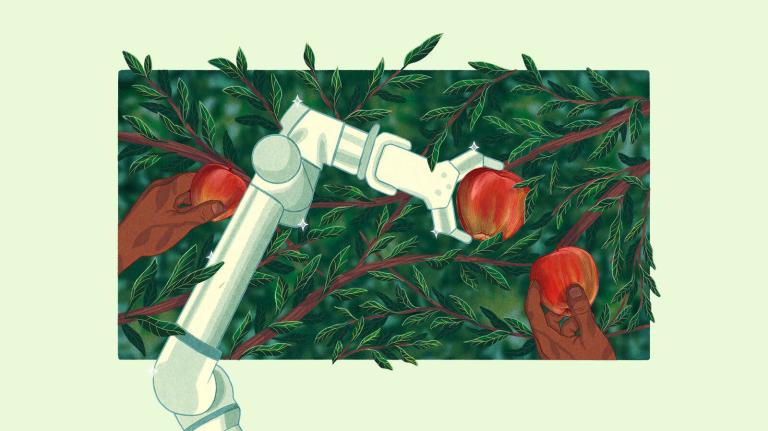This post first appeared on Bitter Greens Journal.
Maverick Farms, where I work, lies on a dirt road halfway up a steep hollow in the Blue Ridge Mountains. Twenty years ago all the land around here was agricultural. Each family generally had a couple of milk cows, a pig or two, and a garden plot to feed themselves; for cash, they planted cabbage (to be sold to a nearby sauerkraut factory, long gone) and tobacco.
All of that has changed. The word “farm” has become a marketing tool to move real estate, and little else. The only other entity with “farm” attached to its name on our road is “Clark’s Creek Farm” — a suburban-style subdivision.
Our area is a magnet for SUV-driving second-home seekers and the real-estate flacks who serve them. Up the road from us, the dirt flies as machines rip into the mountainside to create new lots for fancy homes. Starting at about 7:00 a.m., the rooster’s hoarse cry is drowned out by the steady roar of giant trucks careening up the mountain, carrying construction material and machinery.
Nearly everyone up there wants the road to be paved — it would make construction so much easier, and you could comfortably drive your SUV faster than 20 mph to get up and down the mountain. We say: Hell, no. We’re joined in our refusal by two neighbors, people with deep family roots in the area who don’t want to see our holler turned into a suburb of Orlando or Charlotte. We refuse to sign the papers that would force the road’s paving.
In the end, we will lose and the developers and second-homers will win. They will have forcibly created the logic that makes the road’s paving “necessary.” Carve enough mini-mansions into the mountainside, cram the road with enough construction trucks and “utility” vehicles, and of course it will have to be paved. It will become a safety issue. The road as it is will have to be condemned; a handsome strip of asphalt will rise up in its place. Progress! And goodbye to our chicken shed and springhouse.
I tell this bitter story to illustrate what’s going on with genetically modified (GM) food in Europe. Bear with me. An organization called Agricultural Biotechnology Europe, a PR front for Monsanto, Syngenta, Dupont, et al, recently commissioned a study of the costs to food conglomerates of pursuing a “GM avoidance” strategy.
First some background. Partially because of high-profile campaigning from the likes of Greenpeace, a large swath of European society has rejected GM food and demands that it be labeled as such at the supermarket. Those demands have forced grain-processing giants such as Archer-Daniels Midland and Cargill to do something they hate doing: Make distinctions in what they consider to be a sea of sameness. No longer can a soybean be a soybean be a soybean. Now they must separate GM from non-GM — a service for which they naturally charge a premium.
The dilemma mostly centers on soybeans, which Europe mostly imports from the Americas. The continent grows most of its own corn, which thus far is almost totally non-GM.
When Roundup-ready soybeans first sprang to life in U.S. fields in 1996, ADM and Cargill solved the Europe problem by diverting U.S. soybeans away from the European food market (though they kept GM soy flowing into the animal-feed market), and sent the Europeans Brazilian soy (the same corporations are dominant buyers in South America). At that time, Brazil had banned GM seeds.
In the meantime, Roundup-ready soy gained a foothold in Brazil, as farmers bought the seeds on the black market from Argentina and then saved them for future planting, thumbing their noses at Monsanto. Then, in 2005, the Brazilian government approved the planting of GM crops. That means the supply of non-GM soy has been shrinking.
For European food conglomerates bending to consumer pressure to produce “non-GM” food, that will mean higher prices for non-GM soy, the study argues. Already, the study reckons that 51 percent of the soy grown globally is GM; and fully 90 percent is “dominated by GM-origin material,” meaning soy that’s stored without any careful separation of GM and non-GM material. So supplies of non-GM soy are already tight.
Right now, non-GM soy draws a 5-10 percent premium over GM soy on the market. As supplies dwindle, the study says, the premium could go as high as 25 percent. (Interestingly, Brazilian farmers get no premium for growing non-GM soy; all the extra cash now accrues to the processor, the study reports.)
Bottom line: If you want GM-free processed food, you must pay Archer-Daniels Midland a nice premium. I predict that as the premium grows, European consumer resistance to GM food will fade — and Monsanto’s seeds will take over the Brazilian savanna much as they have the Midwestern plains and the pampas of Argentina.
And here is where we arrive at the conceptual link between land politics in my area of North Carolina and food politics in Europe. Just as developers and vacationers here have created the necessity of fulfilling their goal — turning our road into a suburban-style throughway — the GM seed trusts have overwhelmed the food system with their seeds, creating conditions that will eventually force acceptance.
Like so many of my posts, this one will end with a plea for consumers to remove themselves from the commodity system as much as possible by avoiding the supermarket and seeking sustenance at the farmers market and from backyard and neighborhood plots.
